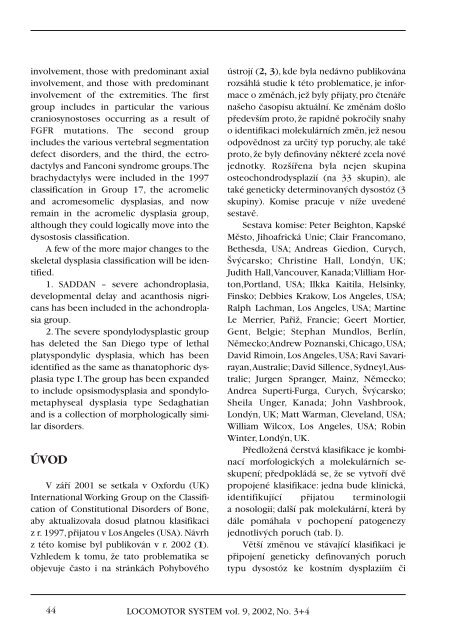3+ 4/2002 - Společnost pro pojivové tkáně
3+ 4/2002 - Společnost pro pojivové tkáně
3+ 4/2002 - Společnost pro pojivové tkáně
You also want an ePaper? Increase the reach of your titles
YUMPU automatically turns print PDFs into web optimized ePapers that Google loves.
involvement, those with predominant axial<br />
involvement, and those with predominant<br />
involvement of the extremities. The first<br />
group includes in particular the various<br />
craniosynostoses occurring as a result of<br />
FGFR mutations. The second group<br />
includes the various vertebral segmentation<br />
defect disorders, and the third, the ectrodactylys<br />
and Fanconi syndrome groups.The<br />
brachydactylys were included in the 1997<br />
classificatíon in Group 17, the acromelic<br />
and acromesomelic dysplasias, and now<br />
remain in the acromelic dysplasia group,<br />
although they could logically move into the<br />
dysostosis classification.<br />
A few of the more major changes to the<br />
skeletal dysplasia classification will be identified.<br />
1. SADDAN – severe achondroplasia,<br />
developmental delay and acanthosis nigricans<br />
has been included in the achondroplasia<br />
group.<br />
2. The severe spondylodysplastic group<br />
has deleted the San Diego type of lethal<br />
platyspondylic dysplasia, which has been<br />
identified as the same as thanatophoric dysplasia<br />
type I.The group has been expanded<br />
to include opsismodysplasia and spondylometaphyseal<br />
dysplasia type Sedaghatian<br />
and is a collection of morphologically similar<br />
disorders.<br />
ÚVOD<br />
V září 2001 se setkala v Oxfordu (UK)<br />
International Working Group on the Classification<br />
of Constitutional Disorders of Bone,<br />
aby aktualizovala dosud platnou klasifikaci<br />
zr.1997,přijatou v Los Angeles (USA). Návrh<br />
z této komise byl publikován v r. <strong>2002</strong> (1).<br />
Vzhledem k tomu, že tato <strong>pro</strong>blematika se<br />
objevuje často i na stránkách Pohybového<br />
44<br />
LOCOMOTOR SYSTEM vol. 9, <strong>2002</strong>, No. <strong>3+</strong>4<br />
ústrojí (2, 3), kde byla nedávno publikována<br />
rozsáhlá studie k této <strong>pro</strong>blematice, je informace<br />
o změnách,jež byly přijaty,<strong>pro</strong> čtenáře<br />
našeho časopisu aktuální. Ke změnám došlo<br />
především <strong>pro</strong>to,že rapidně pokročily snahy<br />
o identifikaci molekulárních změn,jež nesou<br />
odpovědnost za určitý typ poruchy, ale také<br />
<strong>pro</strong>to, že byly definovány některé zcela nové<br />
jednotky. Rozšířena byla nejen skupina<br />
osteochondrodysplazií (na 33 skupin), ale<br />
také geneticky determinovaných dysostóz (3<br />
skupiny). Komise pracuje v níže uvedené<br />
sestavě.<br />
Sestava komise: Peter Beighton, Kapské<br />
Město, Jihoafrická Unie; Clair Francomano,<br />
Bethesda, USA; Andreas Giedion, Curych,<br />
Švýcarsko; Christine Hall, Londýn, UK;<br />
Judith Hall,Vancouver, Kanada;Vlilliam Horton,Portland,<br />
USA; Ilkka Kaitila, Helsinky,<br />
Finsko; Debbies Krakow, Los Angeles, USA;<br />
Ralph Lachman, Los Angeles, USA; Martine<br />
Le Merrier, Pařiž, Francie; Geert Mortier,<br />
Gent, Belgie; Stephan Mundlos, Berlín,<br />
Německo;Andrew Poznanski,Chicago,USA;<br />
David Rimoin, Los Angeles, USA; Ravi Savarirayan,Australie;<br />
David Sillence, Sydneyl,Australie;<br />
Jurgen Spranger, Mainz, Německo;<br />
Andrea Superti-Furga, Curych, Švýcarsko;<br />
Sheila Unger, Kanada; John Vashbrook,<br />
Londýn, UK; Matt Warman, Cleveland, USA;<br />
William Wilcox, Los Angeles, USA; Robin<br />
Winter, Londýn, UK.<br />
Předložená čerstvá klasifikace je kombinací<br />
morfologických a molekulárních seskupení;<br />
předpokládá se, že se vytvoří dvě<br />
<strong>pro</strong>pojené klasifikace: jedna bude klinická,<br />
identifikující přijatou terminologii<br />
a nosologii; další pak molekulární, která by<br />
dále pomáhala v pochopení patogenezy<br />
jednotlivých poruch (tab. l).<br />
Větší změnou ve stávající klasifikaci je<br />
připojení geneticky definovaných poruch<br />
typu dysostóz ke kostním dysplaziím či

















